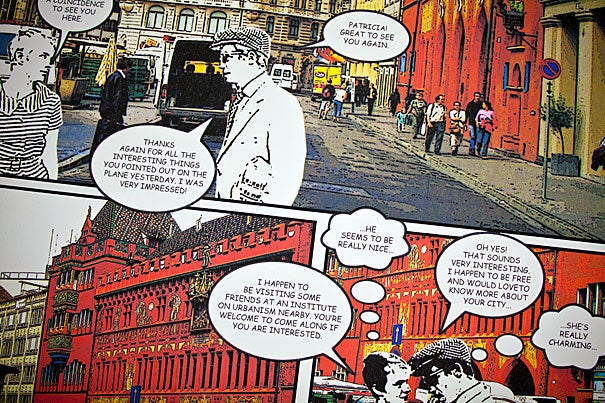
The Harvard Graduate School of Design is turning 75, and celebrating that milestone with GSD 075, a time-blending Gund Hall exhibit on display through Dec. 22. “The anniversary is a way to take a fresh look at the present and future,” said GSD director of exhibitions Dan Borelli, M.Des.S. ’12. “We wanted to show a living institution, and a forward-looking institution.”
Justin Ide/Harvard Staff Photographer
Harvard offered its first architecture classes in 1893, and had an architecture graduate school by 1914. But it wasn’t until 1936 that the Graduate School of Design (GSD) opened. It was a gathering place for all forms of design practice, and an early Harvard experiment in mixing disciplines.
Harvard is 375 years old this year, and the School of Design turns 75. But how do you celebrate GSD’s birthday — and its complex history — without trapping viewers in the past? The answer is GSD 075, a time-blending Gund Hall exhibit on display through Dec. 22.
Looking back is part of the presentation, from letters and sketches of the World War II era to the iconic red fist that blared from Vietnam protest T-shirts in 1969. Looking forward is on display too.
“The anniversary is a way to take a fresh look at the present and future,” said GSD director of exhibitions Dan Borelli, M.Des.S. ’12. “We wanted to show a living institution, and a forward-looking institution.”
Even at age 75, the GSD is — in Harvard terms — something of a child. But this kid has done very well. A roster of past faculty and students reads like a “Who’s Who” of design. Walter Gropius, a pioneering modernist, fled Nazi Germany and settled into a teaching career at the GSD. Josep Lluis Sert, an influential architect and city planner exiled by war in Europe, was GSD dean from 1952 to 1969. Other luminaries include I.M. Pei, Frank Gehry, and Edward Durell Stone.
The 75 years were also a time of fervent innovation. In the 1940s and ’50s, there was Gropius and his formative Bauhaus legacy. In the same era came Sert, busy developing the idea of urban planning as a series of interlayered functions — a taxonomy of place still employed by urban designers. Then there was the GSD computer graphics team that in 1966 laid the foundation for geographic information systems (GIS).
Today, GSD is still in the innovation game. This fall, for one, it started an advanced studies program in “anticipatory spatial practice,” in which students investigate the urban world’s coming environmental and social shocks.
GSD 075 sums up the eclectic past with “dispatches” from every era. There are 120 compact newspaper-like stories that are matched with glass cases of artifacts, pictures, and documents. Above this glassed-in past is the open present — wall displays of faculty work that are expressions of the present and dreams of the future.
For a more linear chronology, viewers can go to an exhibit table mapped in a time line from 1936 to the present. Every image from the show appears in a bright, crowded line of projected images. Touch one, and it flashes up large, along with orienting blocks of text.
The exhibit is “an invitation to steep the current student body and faculty in a bit of history,” said curatorial director Peter Christensen, M.Des.S. ’09, A.M. ’11, a Ph.D. candidate who started assembling the exhibit team in May. (Before coming to the GSD, he was an architecture and design curator at the Museum of Modern Art.)
Viewing the display, Judy Fulton, M.Arch. ’13, president of the GSD Student Forum, was struck by the red-fisted T-shirt exhibit depicting 1969. “I find it especially timely,” she said. “Forty-two years later, the Yard has tents of protesting students, [and] GSD students continue to design for things they’re passionate about.”
The exhibit zooms into these past moments to show how the GSD has always recalculated design based on shifting realities, said Christensen. Even in the era of Gropius and his powerful Bauhaus model, “there were always other voices debating and designing on the other side,” he said. “The hope is that this open system will continue, and the polyphonic quality of the School will continue.”
Getting at GSD history was a challenge. Exhibit researchers, including 18 students, culled artifacts and documents from Special Collections at the Frances Loeb Library. “There’s no real ‘attic’ at the GSD,” said Christensen, but Special Collections archivists Mary Daniels and Ines Zalduendo extracted “some of the more exciting objects out of their dusty lairs.” The exhibit team also drew from personal collections of faculty and alumni and interviewed faculty and former students. The furthest back was Henry N. Cobb ’47, M.Arch. ’49, designer of the John Hancock Tower in Boston.
The exhibit includes 300 artifacts and has more than 200 pages of edited text. That makes the next step a natural: an exhibit book to appear in 2012.
In January, look for a Gund Hall exhibit on the new Amir Building at the Tel Aviv Museum of Art. It was designed by Preston Scott Cohen, M.Arch. ’85.




